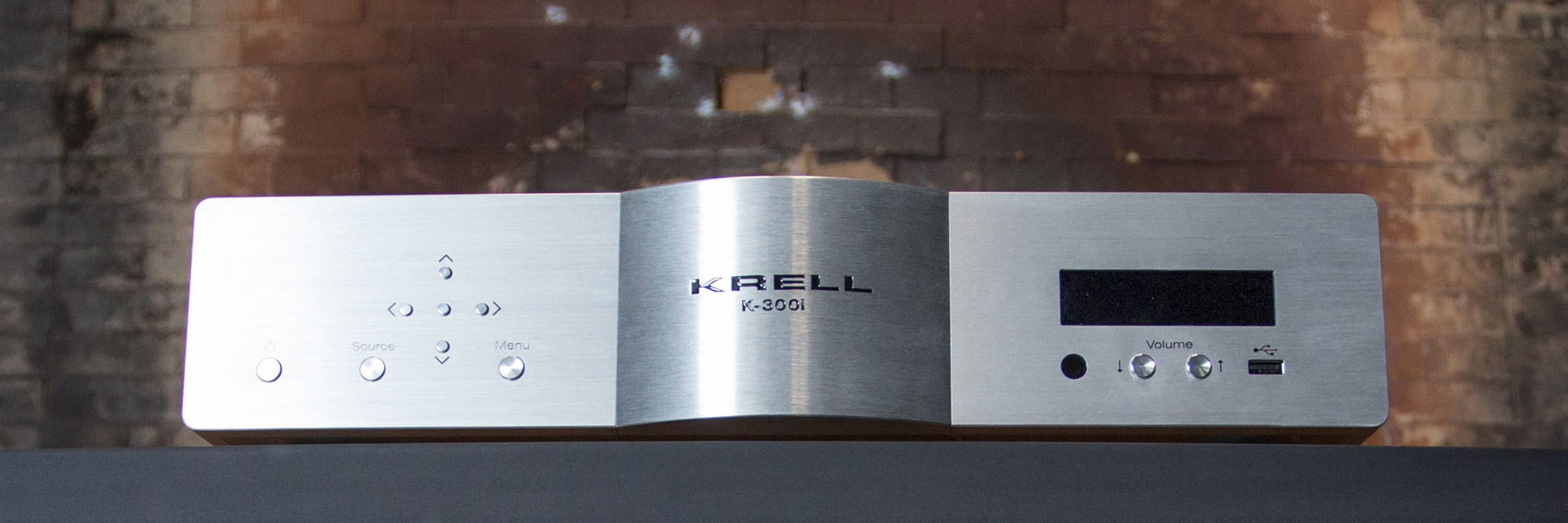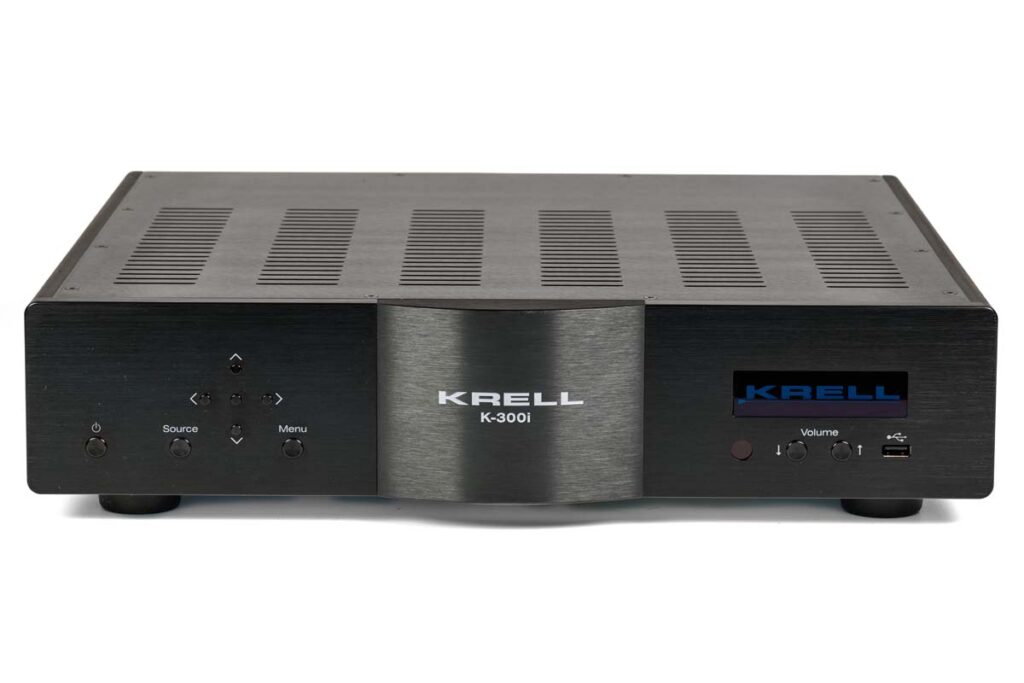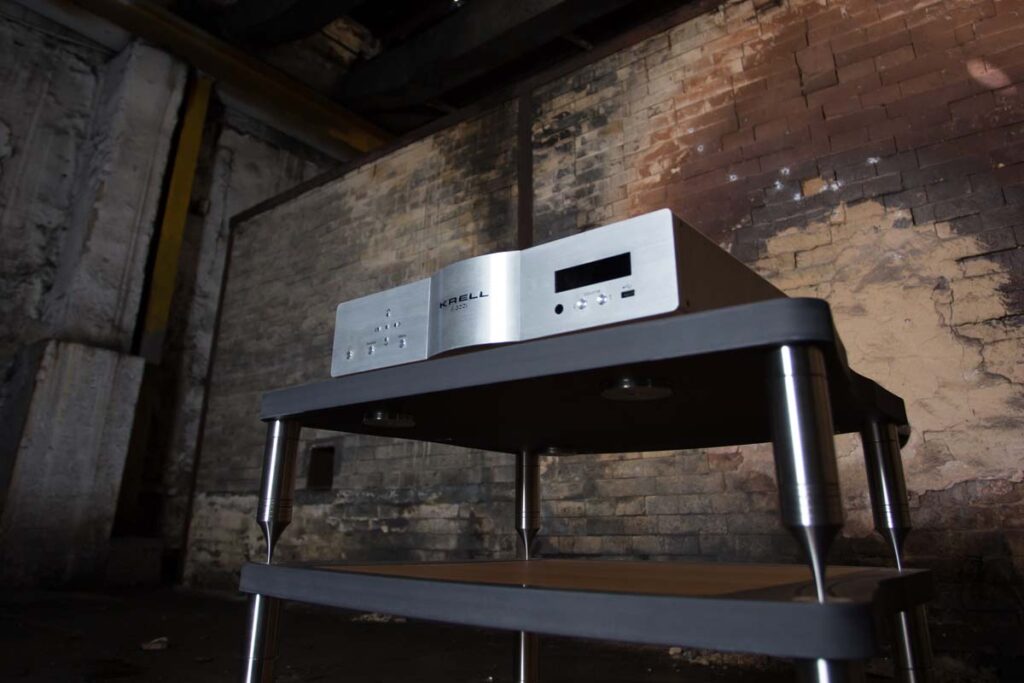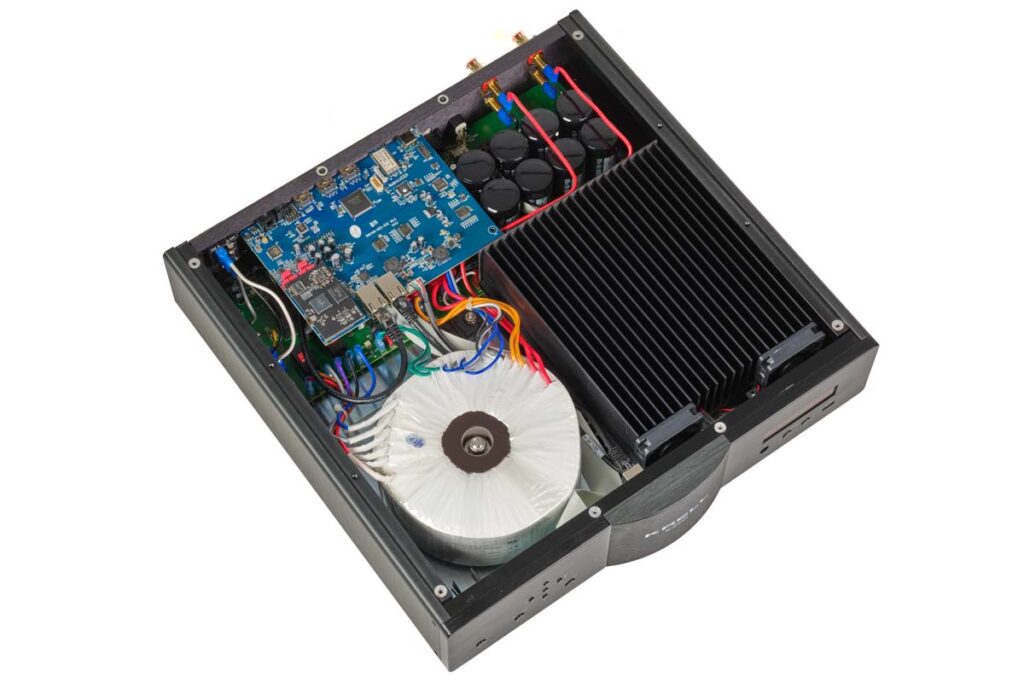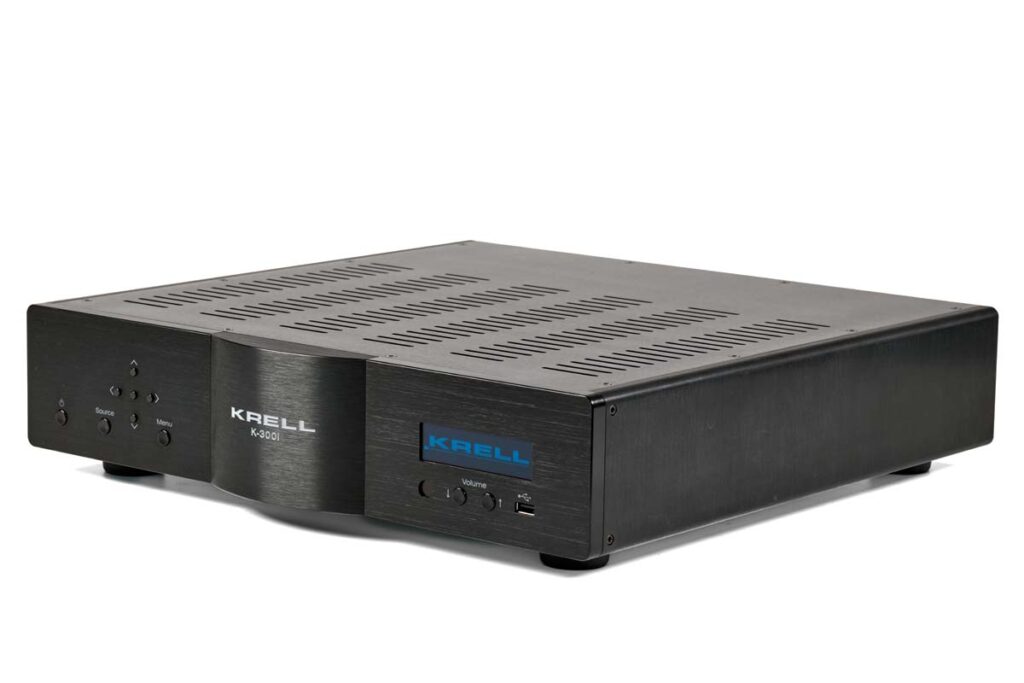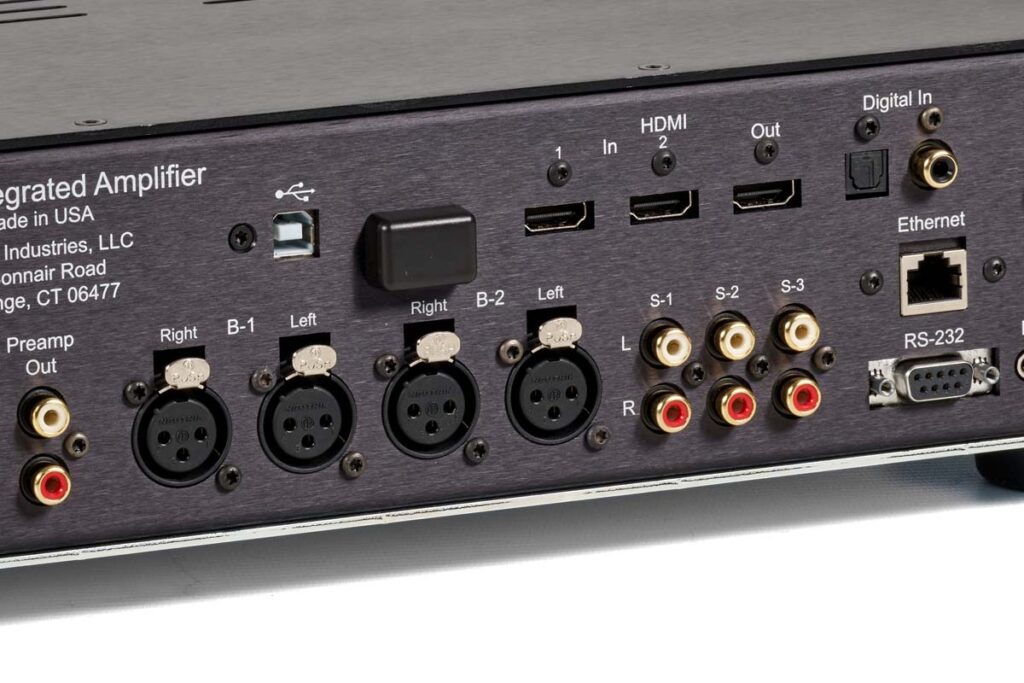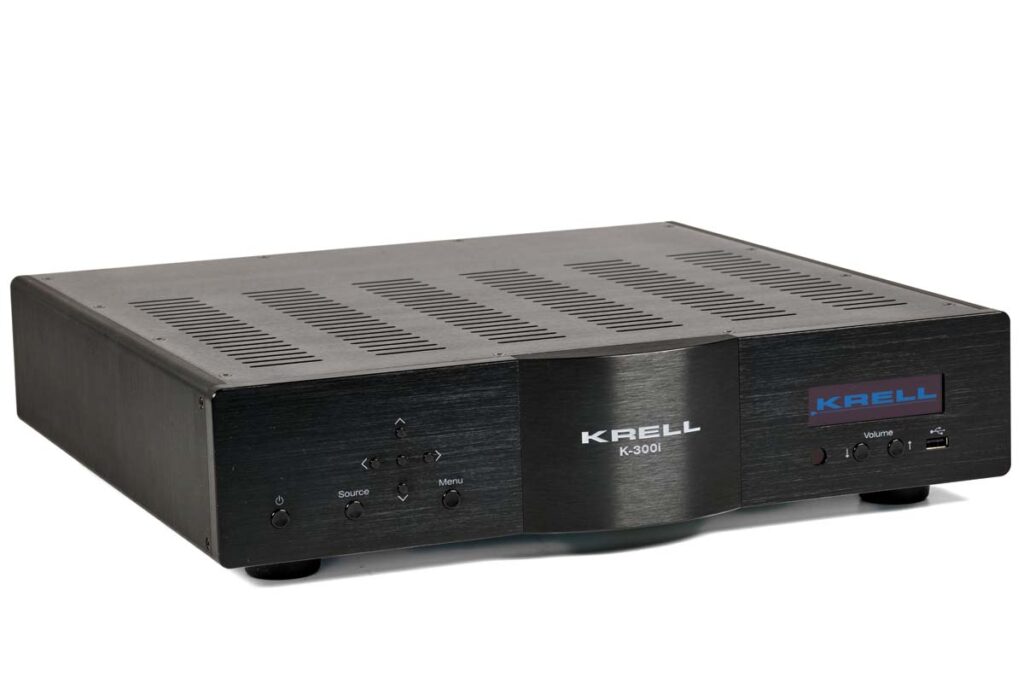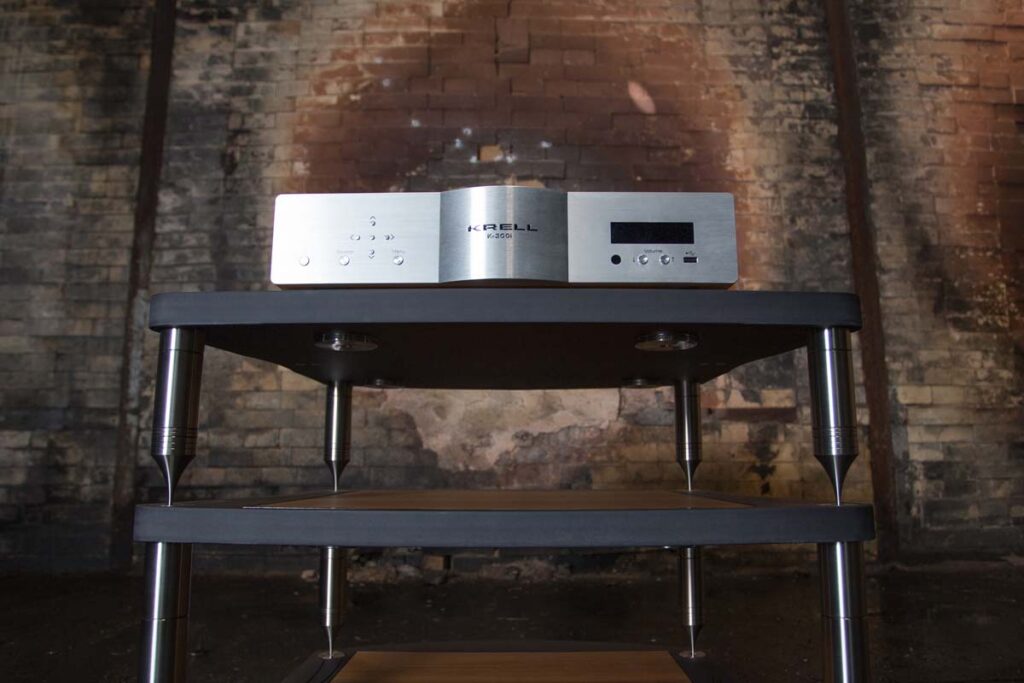Krell’s K-300i integrated amplifier shows how a classic integrated amplifier concept can be made fit for the future with innovative in-house technology.
Can you relate? You’re sitting expectantly at your specialist dealer’s or at a hi-fi enthusiast friend’s, eagerly awaiting the opportunity to inspect the new and highly praised integrated amplifier, and then you’re presented with a plain piece of plastic with gelatinous buttons. In these moments, I always ask myself why I should trust a manufacturer who ships a remote control worth a few cents with an amplifier with a five-figure price tag, which, even if it should work technically, is a haptic and aesthetic insult to my hands and eyes. In Orange, Connecticut, they seem to have similar thoughts, which is why they have included a heavy and massive remote with the Krell K-300i integrated amplifier, whose magnificent weight is the perfect equivalent to the massive construction of the amplifier to be operated.
One to nil for Krell, I think to myself, and at this stage of my test phase I already have a feeling I’m in for two enjoyable weeks, especially as the feature set leaves nothing to be desired: The menu system on the front offers configuration options such as adjustable input sensitivity, which allows different for level matching of different devices. In theater passthrough mode, the K-300i can serve as the heart of a surround system without compromising two-channel sound quality. Now you could say that this should be a matter of course for an integrated amplifier in this price range, but unfortunately this is not always the case. It has paid off that Krell has brought production back to Connecticut after a brief “Made in China” adventure. Fortunately, the aesthetic accidents of the Vanguard series have also been laid to rest and are now back to the indestructible and simple powerhouses of the 90s and noughties. Well done!
Class A for the 21st century
A glance through the cooling slots at the huge transformer and the muscular effort required to heave the amp onto the rack make it clear that no expense has been spared when it comes to the power supply. A 771 VA transformer with a capacity of 80,000 μF forms a more than potent basis for absolute signal control and sufficient dynamic reserves. However, the real developmental highlight, which to a certain extent forms the constructive heart of the K-300i, is the iBias design developed in-house by Krell some time ago, which has replaced the classic Class A topology at Krell. But how does iBias work, the basic idea of which probably goes back to Dan D’Agostino? Class A amplifiers eliminate the distortion that occurs when the audio signal alternates between positive and negative polarity by permanently operating the output transistors at full power so that they are never switched off. Excess power not required to drive the speakers is dissipated via the amplifier’s heat sinks.
In an iBias amplifier, a circuit continuously monitors the current flow through the output transistors and immediately adjusts the power (or bias voltage) supplied to the transistors to meet the requirements. The output transistors are never switched off and only minimal energy is wasted in the form of heat. This amplifier not only consumes less power, but also runs cooler and can be housed in a smaller package. Ultimately, the development is also due to the idea of how the qualities of Class A can be saved in an age of necessary sustainability. Krell also likes to use the comparison that they have developed a car with 12 cylinders, which only increases consumption when it is really needed.
Sensitive show of strength
This full-bodied statement needs to be verified immediately. Some time ago, I came across a CD by Japanese percussionist Isao Nakamura, on which he mainly plays compositions for individual percussion instruments. Thunder by Peter Eötvös for a pedal timpani, which lasts just under five minutes, is a first-class showpiece that appeals to both the intellect and the stomach. The nonchalance with which the Krell powerhouse hurls the timpani cascades into the room is astounding. While you can hear how my Naim SuperNait has to push with noticeable effort in order to adequately place the sound development of the piece in the room, the Krell K-300i conjures Nakamura’s wild playing out of the speakers as if from nowhere and also maintains the necessary tension when the timpani notes slowly fade out to pianissimo. Yet it is anything but a mere demonstration of power that can be heard here. Yes, even at a socially unacceptable volume, the music bursts out with absolute immediacy, yet at no point is it simply beaten around the listener’s ears. There is not a trace of sharpness, there is always a subtle resonance of the notes, and there is always an inimitable flow in the music – all attributes that can certainly be attributed to the specific Class A format of the Krell.
I have gotten into the habit of testing new amplifiers in a second step with rather intimate music at a low volume, as this shows the supporting power of the amp and how it manages to maintain the musical substance even when only a low power is called upon. It is not uncommon to hear more anemic mumbling than audiophile pleasure. And so the album Echoes by the Danish Søren Bebe Trio goes into the CD player. Musically somewhat reminiscent of the legendary Esbjörn Svensson Trio, the recordings impress above all with their outstanding recording quality – even though (or perhaps because) they were self-produced and self-published. When the drums, played with a broom, are positioned a little behind the piano and bass in the room and add a slightly driving nervousness to the static piano chords and the discreetly dabbed bass, a clearly defined division of space is recognizable despite the extremely restrained playing, the bowed cymbals shine with their individual timbre and the beat focuses of the track remain identifiable even at a moderate room volume thanks to the clearly contoured bass. High end just before midnight, even if the neighbors are already asleep? No problem with Krell’s K-300i!
Digital all-purpose weapon
That leaves the question of the digital board, which is available for a good 900 euros extra. It expands the connection options many times over and also enables the integration of audiovisual equipment via the HDMI inputs. Max Merk from the German distributor gave me the tip to connect a PlayStation 5, which my son didn’t need to be told twice: Gaming in a new sonic dimension. The ESS Sabre chipset used converts the input data smoothly and passes it on to the amplifier section without leaving any distracting fingerprints. This is how a DAC should sound – not at all! Anyone who plays AV media or games consoles via a laptop, Mac Mini or similar devices should consider the digital board. However, if you only stream Tidal or Qobuz and already have a good client, you can probably do without the board, especially as the mconnect app intended for control isn’t exactly the last word and the integration of the K-300i is not always entirely problem-free due to IP address conflicts. But this should only be mentioned in passing, after all, we are primarily interested in the K-300i as an integrated amplifier; and as such we let it really blossom again …
Even if the original LP editions are regarded as audiophile highlights of Decca’s history, Georg Solti’s Mahler recordings in the digital reissues are usually a little hissy and not produced with the last bit of depth. With amplifiers that feign tonal transparency by artificially emphasizing the treble, Yvonne Minton’s wonderful alto in the Lied von der Erde can sometimes lose its grip on the ground and stand virtually next to the orchestra at top notes. None of this can be felt in the almost 32 minutes of the final movement “Der Abschied”, which I can really sink into. Whether in the delicate and fragile opening duet between the flute and alto or in the powerful tutti passages in the middle of the piece, the K-300i always succeeds in combining transparency and wholeness, which makes carefree long-term listening possible in the first place.
Nothing left to be desired
So what’s the bottom line? They still exist, the good old-style integrated amplifiers that were once somewhat impetuously referred to as “juggernauts”: Power without end, built like an armored cabinet and a clear design without any big frills. But beware: technically and musically, this is anything but oldschool. Although the venerable principle of Class A is still the benchmark, the iBias technology has adapted the former concept of wasting heat and energy to current requirements, and musically, the powerhouse from Orange shows that it also has an honest need for the finest dynamic gradations and focused spatial imaging. And the fact that this classic amp is also “digital ready” is all the more reason to include the Krell K-300i in the list of final amplifiers that the audiophile heart could desire.
Accompanying Equipment
Turntables: Thorens TD 126 MK III, Technics SL-1210 MK2 | Tonearm: Koshin GST 801 | Cartridges: Sumiko Blackbird, Ortofon Concord Century | Phono preamplifier: Innovative Audio Ultimate 2b, Thel Phono M | CD player: Naim CD 5i | Streamer: Naim CD5XS | Integrated amplifier: Naim SuperNait | Speakers: Gamut Phi 7 | Headphones: Beyerdynamic DT 1770 Pro | Accessories: Wireworld, Sommer, Creaktiv
Integrated amplifier Krell K-300i
Concept: Stereo integrated amplifier with DAC and streaming functionality | Inputs: 3 x RCA, 2 x XLR; with digital module additionally: 1 x coaxial, 1 x optical, 2 x HDMI, 1 x USB host, 1 x USB device | Outputs: 1 x pair of speakers, 1 x HDMI, 1 x RCA preamp | Output power (8/4 Ω): 2 x 150 W/2 x 300 W | Colors: black, silver | Dimensions (W/H/D): 44/11/46 cm | Weight: 24 kg | Warranty period: 2 years (plus 2 additional years with registration) | Price: around €13,650 with digital module (€12,700 without)
Audio Reference
Alsterkrugchaussee 435
22335 Hamburg
Phone +49 40 53320359
info@audio-reference.de

